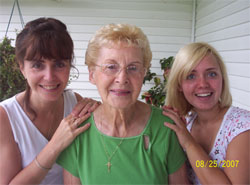Religious Education Supplement
A family affair:
Three generations of women serve as catechists

From left, Tamara Dible, Lucille Wojasinski and Grace Dible share a moment during a recent family reunion. The three women also share a love for spreading their faith. (Submitted photo)
By John Shaughnessy
You could tell the story as the tale of three generations of women—focusing on the bonds that have formed between an
81-year-old woman, her 41-year-old daughter and her 17-year-old granddaughter.
You could also take a different approach—concentrating on the positive example that family members can have on each other in terms of their lives and their Catholic faith.
Benedictine Sister Joann Hunt would even add another element to the story—the pursuit of a dream.
“Our dream is to hand on our faith and our values from generation to generation,” says Sister Joann, the director of religious education at Holy Spirit Parish in Indianapolis. “There’s no way the Church can go on without people being willing to share their faith and their values.”
Whichever approach you take, they all lead to the story of Lucille Wojasinski, Tamara Dible and Grace Dible—three women from different generations of the same family who have embraced their roles as catechists seeking to shape the faiths of others.
Their combined commitment has extended for about 35 years, a commitment that began when Lucille timidly volunteered to help with religious education on Sundays even though she was a mother of five, including a child who was deaf.
“I went in shaking,” Lucille, 81, recalls. “I didn’t think when I started that I’d make it through the first year. But by Christmas, I was looking forward to it so much and seeing the kids take to it.
“We’d have a celebration for their first penance and their first Communion. My heart would melt to see them up there. Just to know there would be another soul for God. I stayed at it about 15 years. I probably would have stayed on longer but my husband, Ed, had a heart attack and he needed a lot of help.”
Lucille’s daughter, Tamara, was 5 when her mother began teaching religious education at St. Stanislaus Parish in Michigan City, Ind., in the Gary Diocese. Through her childhood, Tamara noticed her mother’s involvement and volunteered herself, beginning in the seventh grade and continuing through her senior year in high school.
Years later, Tamara returned to teaching religious education when she, her husband and their three daughters moved to Indianapolis.
Sister Joann remembers when Tamara offered to volunteer at Holy Spirit Parish about 10 years ago.
“Most DREs [directors of religious education] pass out when they have someone volunteer,” Sister Joann says with a laugh. “I asked her what made her interested. She said her mother had done it.”
Tamara acknowledges her mother’s influence.
“She was my role model,” Tamara says. “Parents influence their kids in good ways and bad ways, and they don’t realize it. If you smoke, your kids will see that. If you go to church and put God first, kids will see that. It begins at home. You hope as a parent you’re doing the right thing.”
Tamara’s example was noticed by her daughter, Grace. Following in her mother’s footsteps, Grace approached Sister Joann and volunteered to help with religious education at Holy Spirit, citing her mother’s example. Lightning had struck twice for Sister Joann.
“My mom has been teaching since I was little and it’s something I thought I’d like to do,” Grace, 17, says. “I absolutely love it. I started helping when I was in the eighth grade.”
As special as the family bond is, all three women also mention how their involvement has created a deeper connection to the larger family of the Church.
“I think God tells you sometimes, ‘You better go out there and do something to help,’ ” Lucille says. “We need to get our kids at a young age. If we teach them at a young age, they’re going to be good Christians and Catholics.”
Her granddaughter also believes that having youths and young adults lead religious education makes a difference to children.
“I think it helps to have a younger influence with religious education,” Grace says. “If the kids see an older kid involved in their faith, it encourages them to want to do it, too.”
Teaching religious education has also deepened the faith of the three women.
“It’s made my faith stronger,” Tamara says. “When you go to plan a lesson, it makes you look deeper. My first lesson for sixth grade is teaching the Apostles’ Creed. I have to be able to teach it to them, so I have to understand it and explain to them why we’re learning it.”
As the link between her mother and daughter, Tamara savors the way they have each embraced the importance of religious education.
“It means we’re all pretty strong in our faith,” Tamara says. “I hope we all get to heaven someday.”
Sister Joann appreciates the example the three women have set.
“It shows the power of parents’ example and the influence it has on their children,” Sister Joann says. “Good example pays off even if it takes 10 to 20 years down the line to see it. That example is a matter of life and death for the Church. It keeps bringing new leadership into the Church, new people who are committed to sharing their time and their talent. This is what keeps the Church living and growing.” †
